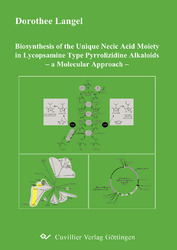| Areas | |
|---|---|
| Serie de libros (96) |
1377
|
| Nachhaltigkeit |
3
|
| Gesundheitswesen |
1
|
| Letra |
2361
|
| Ciencias Naturales |
5403
|
| Matemática | 229 |
| Informática | 318 |
| Física | 979 |
| Química | 1362 |
| Geociencias | 131 |
| Medicina humana | 243 |
| Estomatología | 10 |
| Veterinaria | 108 |
| Farmacia | 147 |
| Biología | 835 |
| Bioquímica, biología molecular, tecnología genética | 121 |
| Biofísica | 25 |
| Nutrición | 45 |
| Agricultura | 1004 |
| Silvicultura | 201 |
| Horticultura | 20 |
| Ecología y conservación de la tierra | 148 |
| Ciencias Ingeniería |
1788
|
| General |
97
|
|
Leitlinien Unfallchirurgie
5. Auflage bestellen |
|
Erweiterte Suche
Biosynthesis of the Unique Necic Acid Moiety in Lycopsamine Type Pyrrolizidine Alkaloids (Tienda española)
- a Molecular Approach -
Dorothee Langel (Autor)Previo
Indice, Datei (67 KB)
Lectura de prueba, Datei (210 KB)
Pyrrolizidine alkaloids (PAs) are characterized as typical compounds of plant secondary metabolism. They are considered as plant defence against herbivores. In mammals, PAs show hepatotoxic and carcinogenic activities and were reported to be one of the reasons for livestock intoxications. In insects, PAs show cytotoxic effects for adults and mutagenic results for larvae and pupae. PA-adapted insects sequester PAs for their own defence against predators, some of them use plant PAs as a precursor for their pheromones influencing the mating behaviour.
Considering their chemical structure, PAs are ester alkaloids of a necine base moiety and one or more necic acids. PAs can be grouped by their necic acids, e.g., the senecionine type and the lycopsamine type PAs.
The biosynthesis of special necic acid moieties from lycopsamine type PAs was postulated to be performed mechanistically like the first step in the biosynthesis of the branched chain amino acids valine, leucine, and isoleucine. This first step is catalyzed by an acetohydroxyacid synthase (AHAS, EC 2.2.1.6) which forms a thiamine diphosphate activated hydroxyethyl group (HeThDP) from pyruvate and transfers the resulting C₂ unit upon a second pyruvate or an 2-oxobutyrate. In case of the PA-biosynthesis, an AHAS-like enzyme was postulated to transfer the active C₂ unit upon an 2-oxoisovalerate, which is a branched-chain homolog of 2-oxobutyrate.
The aim of this thesis was to identify the postulated AHAS-like enzyme. The obtained sequences should help to trace back the evolutionary origin of the enzyme involved in the necic acid biosynthesis. Previous results for an enzyme catalyzing the first step in the necine base biosynthesis, the homospermidine synthase, had shown a polyphyletic origin.
Several putative AHAS open reading frames were identified with the help of a degenerate oligonucleotide primed PCR approach from three lycopsamine type PA producing plants: Eupatorium cannabinum, Asteraceae, Symphytum officinale, Boraginaceae, and Parsonsia laevigata, Apocynaceae.
Interestingly, heterologous expression in E. coli succeeded in soluble and active enzyme only by co-expression of AHAS catalytic and regulatory subunits in the same bacterial host cell.
The recombinant AHAS-like enzyme accepted pyruvate as well as 2-oxoisovalerate as a substrate determined by GC-MS detection. Hence, it was shown that the postulated participation of an AHAS-like enzyme in the formation of lycopsamine type PA necic acids is correct.
| ISBN-10 (Impresion) | 3867276463 |
| ISBN-13 (Impresion) | 9783867276467 |
| ISBN-13 (E-Book) | 9783736926462 |
| Idioma | Inglés |
| Numero de paginas | 228 |
| Edicion | 1 |
| Volumen | 0 |
| Lugar de publicacion | Göttingen |
| Lugar de la disertacion | Braunschweig |
| Fecha de publicacion | 23.07.2008 |
| Clasificacion simple | Tesis doctoral |
| Area |
Bioquímica, biología molecular, tecnología genética
|








